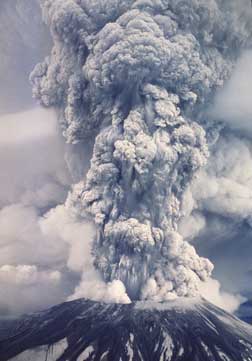Our planet is teaming with violent things that can happen. Do you know some of them? Well, in this article you may discover violent and historic things that have happened on this planet Earth. Hey, this is Nateenka signing in.
Volcanoes
Do you know why volcanoes blow their tops? Volcanoes are mountains that spit fire. Deep under the Earth is red-hot, runny rock called magma. Sometimes the magma bursts up through a crack in the Earth's crust and a volcano erupts. Lava is magma that has erupted from a volcano. Some lava is thick and lumpy. Some is thin and runny. In the air, it cools and turns into hard, black rock.
In AD 79, Mt. Vesuvius in Italy blew its top in a massive explosion. The nearby city of Pompeii was buried under a huge cloud of hot ash and rock. Thousands of people were suffocated and lost their lives. Others fled out away from the city. Volcanoes sleep for hundreds, even thousands of years. A sleeping volcano is called dormant, but it can wake up any minute! A volcano that still erupts is called active. An extinct volcano is one that is never likely to erupt again.
This is Mt. Saint Helen's eruption cloud!

Earthquakes
The Earth's surface is cracked into enormous pieces which drift on the red-hot, runny rock below. Sometimes two pieces push and shove each other, making the Earth shake. Big earthquakes do lots of damage. Huge cracks open up in the ground. Houses, roads and bridges shake and fall to the ground. In the worst earthquakes, many people are killed and injured by buildings that collapse on top of them. An earthquake sends shock waves rippling through the ground. Scientists study these waves to see how big the earthquake is. They measure earthquakes on a scale from 1 to 10. Each quake on the scale is 30 times worse than the one before.
Tsunamis
Tsunamis are gigantic waves which can be 100 feet high and 125 miles long. The word tsunami means "harbor wave" in Japanese because of the way the waves crash into the harbor. They are also called tidal waves. Tsunamis are triggered off by volcanoes or earthquakes under the sea. At first, the waves are low as they speed across the sea. As they reach land, the water piles up into a massive wave which crashes down on the shore. When a tsunami hits land, watch out! It smashes down on to the shore, washing houses, people and boats away. A tsunami can sweep a boat into the air and dump it far away. Did you know that the biggest tsunami in history was as tall as the Statue of Liberty? Interesting huh. That colossal wave was 280 feet high, almost as tall as the Statue of Liberty. It swept past Japan in 1971.
Thunderstorms
Thunderstorms usually happen on a hot, summer's day when the air is warm and sticky. Watch out for huge, dark, tall thunderclouds gathering in the sky. They're a sure sign a storm's brewing. Time to head indoors! Lightning is incredibly hot, about five times hotter than the Sun's surface. As it streaks through the sky, it heats the air so quickly that it makes a loud booming sound. That is the sound of thunder. Thunder starts in cumulonimbus clouds. They turn the sky purple-black and blue. Some of these clouds are massive. The tallest can grow 12 miles high. That's more than twice the height of Mt. Everest! That's pretty high! Did you know that lightning and thunder happen at the same time? Remember that, because it doesn't mean that it's that far away! They don't count as miles or kilometers!
This is a cumulonimbus cloud.

Lightning
Inside a thundercloud, strong winds hurl droplets of water around. They bump and bash into each other. This makes the cloud crackle with static electricity which builds up and suddenly streaks through the sky as lightning. Lightning can flash inside clouds or from cloud to ground. The Empire State Building is struck by lightning about 500 times a year! Many tall building, such as churches and skyscrapers, have lightning conductors to carry the electricity of the lightning safely away. Park ranger, Roy C. Sullivan, was struck by lightning a record of seven time. He suffered burns, singed hair and eyebrows, and he even lost his toenails! Lightning comes in different shapes, such as forked, sheet and ribbon lightning. Ball lightning looks like a ball of fire. People have seen balls of lightning float into their house, then explode with a bang! Isn't that neat?
This is lightning that is spread apart.

Thank you for taking your special time to read this article, this is Nateenka signing off. Bye!